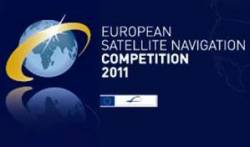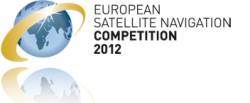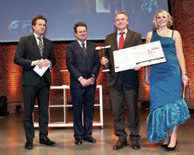
The European Satellite Navigation Competition (ESNC) 2011 opened its registration page on April 1 for entries in this year’s international search for new GNSS applications and product developments.
This year’s competition offers business start-up aid worth €1 million ($1.4 million) and a cash prize pool of €100,000.
The European Satellite Navigation Competition (ESNC) 2011 opened its registration page on April 1 for entries in this year’s international search for new GNSS applications and product developments.
This year’s competition offers business start-up aid worth €1 million ($1.4 million) and a cash prize pool of €100,000.
As a result of the rapid expansion and participation in the eight-year-old ESNC, this year’s competition sees the three-month window for submissions to the ENC “ideas database” opening a month earlier than has been traditional. Entries must be completed by June 30, with regional evaluations taking place during July/August, an international judging on September 8–9, and an October 19 awards ceremony at a state reception in der Residenz in Munich, Germany.
Organized by the Anwendungszentrum Oberpfaffenhofen (AZO) and held under the patronage of the Bavarian Ministry of Economics, Transport, Infrastructure and Technology, ESNC 2011 will have more than 20 regional competitions around the world, including the USA Challenge, organized by Inside GNSS magazine.
In the 2010 competition, an Austrian start-up company, Mobilizy, took home the €20,000 grand prize for its Wikitude Drive navigation system, which uses augmented reality to superimpose driving directions over live street video on smartphones. Last year’s USA Challenge winner was a mobile voting applications, eVOTZ.
Six industrial and institutional partners will sponsors special topic prizes: the European GNSS Agency (GSA), the European Space Agency (ESA), the German Space Agency (DLR), NAVTEQ (which will award two special topic prizes), and the GNSS Living Lab prize. Inside GNSS will again serve as the ESNC’s global media partner.
For the first time, the Industrial Technology Research Institute (ITRI) will award a prototyping prize, the “Galileo Pro.” The ITRI prototyping award is not considered a special topic prize and will therefore not be considered for international evaluation. So, the winner cannot become Galileo Master. Instead, eight finalists will be invited to Taiwan on September 18 to demonstrate their prototypes to a jury.
In addition to their regional competitions, ESNC participants can either apply for one of the special topic prizes or for the prototyping prize. The overall ESNC winner — designated as the Galileo Master — will be chosen from among the regional winners and the special topic winners.
The main prize will be a grant of €20,000, awarded by AZO and the GSA. In addition, the Galileo Master will get the chance to enter a six-month incubation program in a region of his or her choice to realize the winning idea.
On October 20, a day after the Awards Ceremony, the regional and special topic winners have the opportunity to present their solutions at the sMove 360° trade fair in Munich.
Also, this year entries will again be eligible for the ESNC Audience Award based on votes from Internet visitors who register on the ESNC website. When filling out the online questionnaire, participants are asked to optionally summarize their ideas to enter for the ESNC Audience Award. These public abstracts will be published on a special ESNC website page after the international evaluation meeting which will take place on 8/9 September in Brussels.
Three successful candidates will be awarded with patent consulting sponsored by Maiwald Patentanwaltsgesellschaft mbH.
An international kick-off event organized together with GNSS Research & Applications Center of Excellence (GRACE) at the University of Nottingham, is planned May 11 at the Institution of Engineering and Technology (IET) in London, England.
The agenda will include information on the ESNC and the various prizes as well as market overview sessions for different fields of applications. The event will be opened with an “elevator pitch” session: five-minute presentations about entrants’ business ideas to a jury.
The kick-off Conference will be opened by Carlo des Dorides, the new executive director of the GSA. Representatives of the competition’s sponsors will introduce this year’s special topic prizes and the ESNC benefits for participants in 2011.
How to Enter ESNC 2011
This year’s ESNC ideas database feature new, user-friendlier features. Once the participants have created a personal account on the ESNC website, a confirmation e-mail will be sent to them. They then validate their account by clicking on the provided link and log-in with their username (i.e., e-mail address) and their chosen password.
Participants can submit more than one idea using the same personal account and can log into the database to continue developing their idea as often as they like before the database closes at the end of June.
The database is divided into three different sections: technical, commercial, and legal. The technical section asks participants to describe their idea as clearly and accurately as possible; the commercial section addresses the market potential of their idea; and the legal section deals with the idea’s formal project aspects and its trademark and patent rights.
In addition to written responses, ESNC participants can provide images, logos, or figures to clarify and support their proposals. They can edit all entries any time and update their idea as often as they like before the June 30 deadline.
Regional and international judges will assess the ideas based primarily on the following criteria:
• Benefit of the idea
• Advantage of the idea compared to other existing or traditional solutions
• Technological feasibility of the idea
• Significance of the use of GNSS for the realization of the idea
• Time it would take to implement this idea (time to market)
• Chances of this idea becoming a commercial success
• Ability to patent the idea
• Legal risks involved in the idea
• Investment potential for the idea
• Innovation level of the idea
Using the website interface, whenever revised material is saved on-line, the ESNC software calculates the percentage of required data that has already been submitted. The user interface displays a list of any incomplete data fields. The submission status has to be at 100 percent when the database closes; otherwise, incomplete ideas will be considered invalid and enter the evaluation.




